
How to Use RELAY 1CH: Examples, Pinouts, and Specs
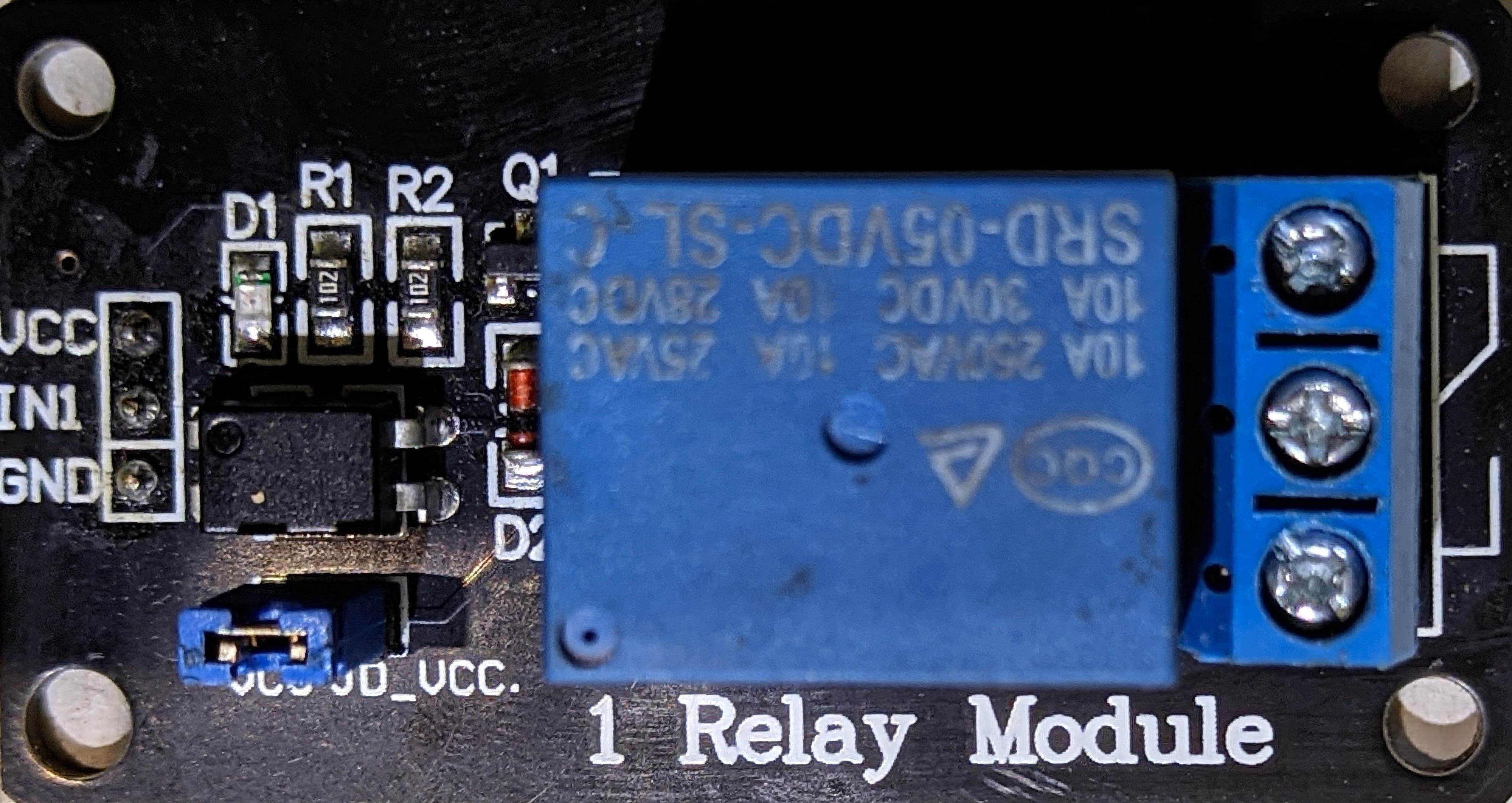
 Design with RELAY 1CH in Cirkit Designer
Design with RELAY 1CH in Cirkit DesignerIntroduction
The RELAY 1CH is a single-channel relay module designed to control high voltage or high current devices using a low voltage signal. It provides electrical isolation between the control circuit and the load, ensuring safety and reliability in various applications. This module is widely used in home automation, industrial control systems, and DIY electronics projects.
Explore Projects Built with RELAY 1CH
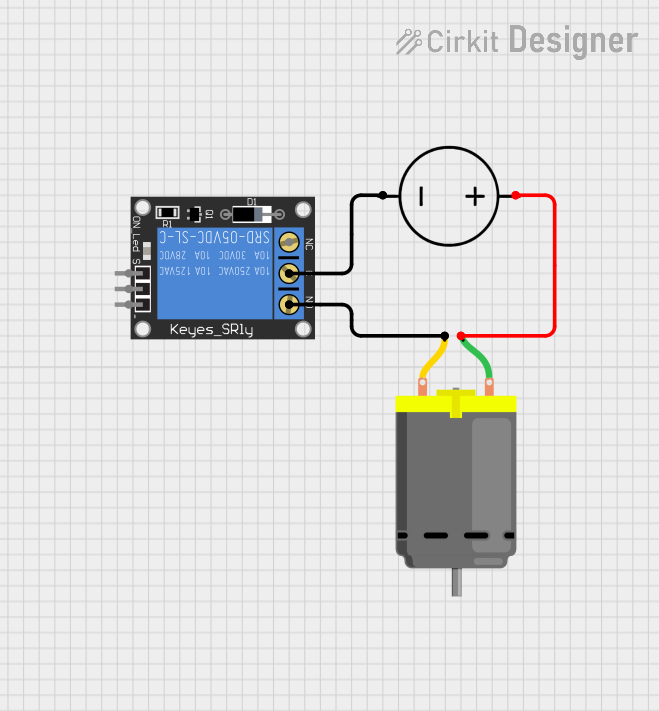
 Open Project in Cirkit Designer
Open Project in Cirkit Designer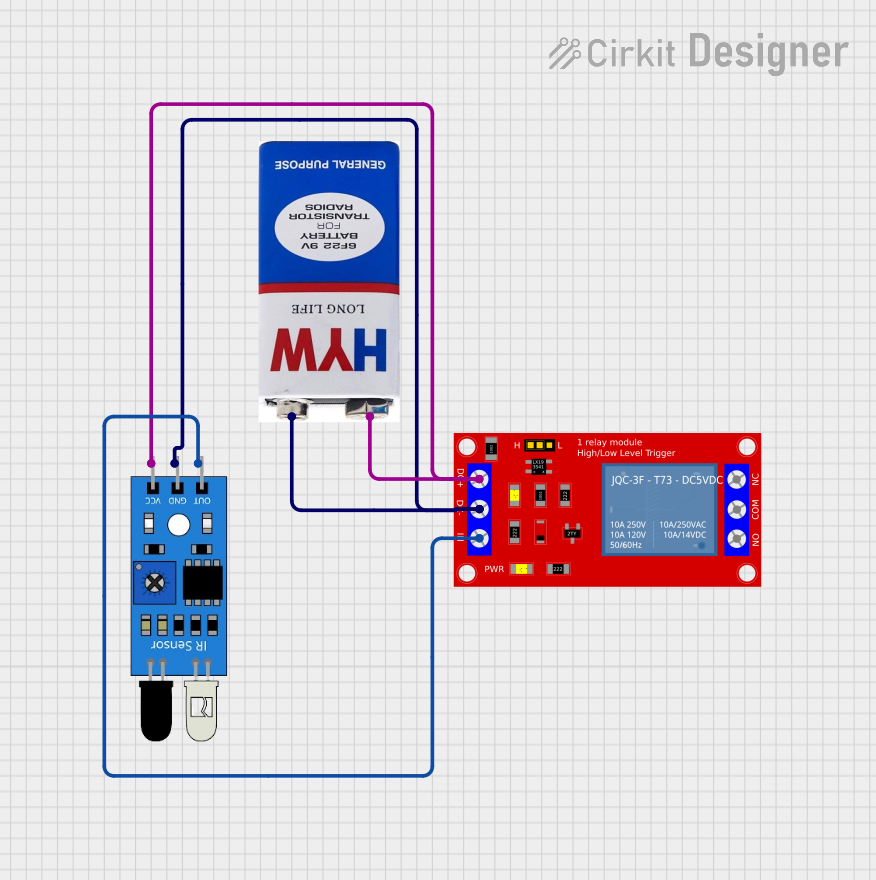
 Open Project in Cirkit Designer
Open Project in Cirkit Designer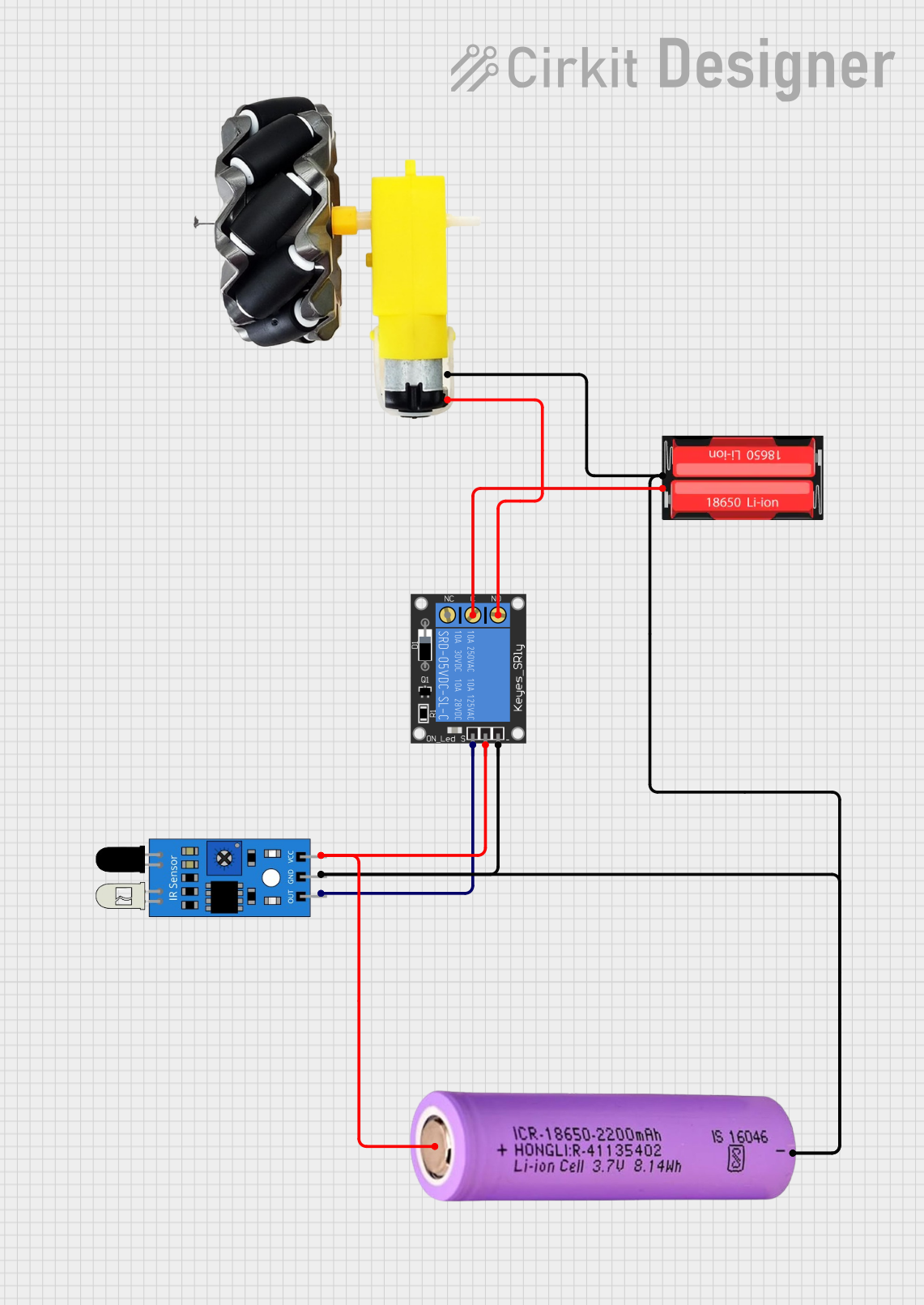
 Open Project in Cirkit Designer
Open Project in Cirkit Designer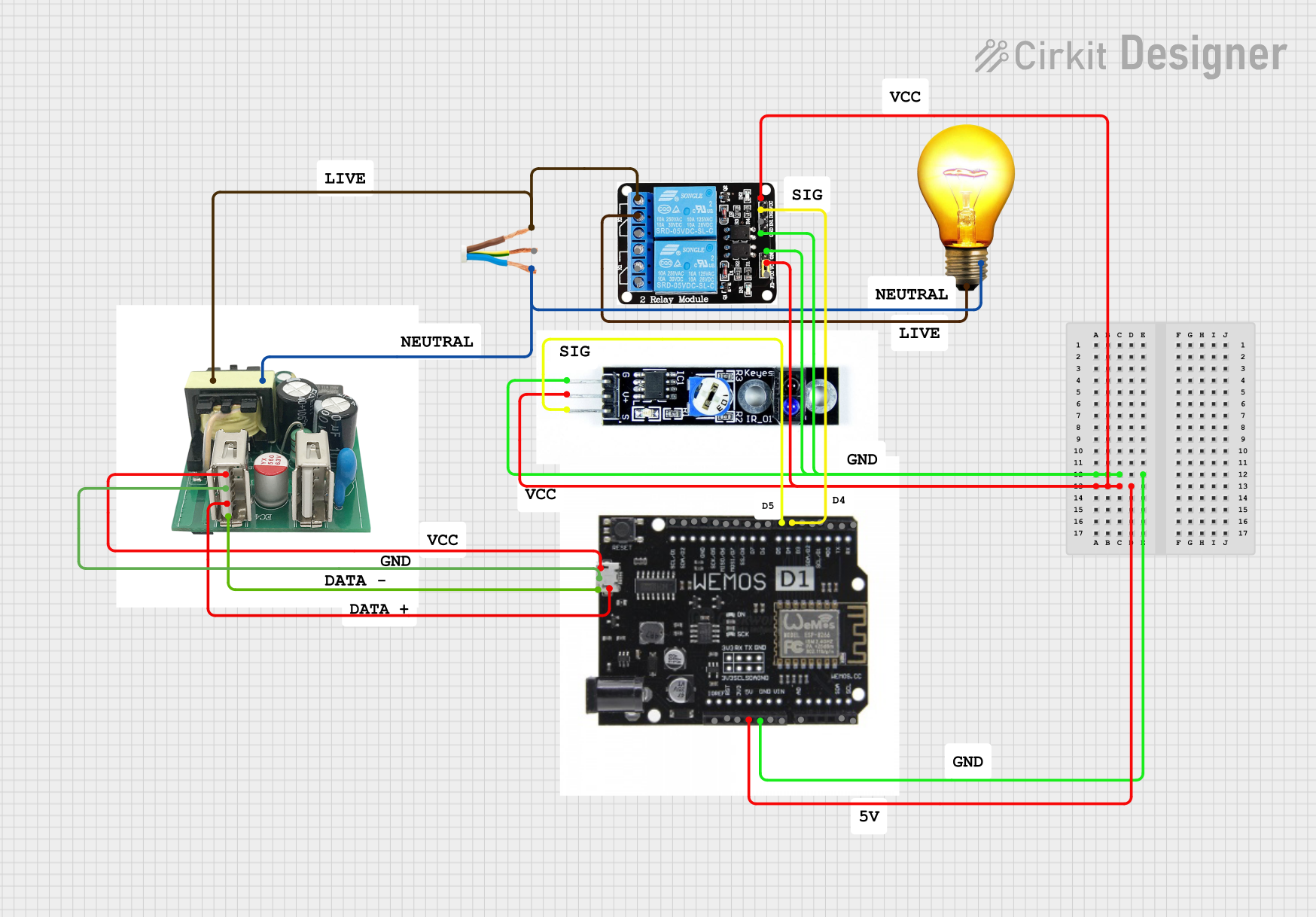
 Open Project in Cirkit Designer
Open Project in Cirkit DesignerExplore Projects Built with RELAY 1CH

 Open Project in Cirkit Designer
Open Project in Cirkit Designer
 Open Project in Cirkit Designer
Open Project in Cirkit Designer
 Open Project in Cirkit Designer
Open Project in Cirkit Designer
 Open Project in Cirkit Designer
Open Project in Cirkit DesignerCommon Applications and Use Cases
- Home automation (e.g., controlling lights, fans, or appliances)
- Industrial equipment control
- Motor control systems
- IoT projects for remote device management
- DIY projects requiring high voltage switching
Technical Specifications
The RELAY 1CH module is built to handle a wide range of control and load requirements. Below are its key technical details:
General Specifications
| Parameter | Value |
|---|---|
| Operating Voltage | 5V DC |
| Trigger Voltage | 3.3V to 5V DC |
| Maximum Load Voltage | 250V AC / 30V DC |
| Maximum Load Current | 10A |
| Relay Type | SPDT (Single Pole Double Throw) |
| Isolation | Optocoupler-based electrical isolation |
| Dimensions | ~50mm x 26mm x 18mm |
Pin Configuration and Descriptions
| Pin Name | Description |
|---|---|
| VCC | Connect to the 5V DC power supply. Powers the relay module. |
| GND | Connect to the ground of the power supply. |
| IN | Control signal input. A HIGH signal activates the relay, and a LOW signal deactivates it. |
| COM | Common terminal for the relay switch. |
| NO | Normally Open terminal. Connect the load here if it should be OFF by default. |
| NC | Normally Closed terminal. Connect the load here if it should be ON by default. |
Usage Instructions
How to Use the RELAY 1CH in a Circuit
- Power the Module: Connect the VCC pin to a 5V DC power source and the GND pin to the ground.
- Control Signal: Connect the IN pin to a microcontroller (e.g., Arduino UNO) or any other control circuit capable of providing a 3.3V to 5V signal.
- Load Connection:
- Connect the load's live wire to the COM terminal.
- Depending on the desired default state of the load:
- Use the NO terminal if the load should be OFF when the relay is inactive.
- Use the NC terminal if the load should be ON when the relay is inactive.
- Activate the Relay: Send a HIGH signal to the IN pin to activate the relay and switch the load.
Important Considerations and Best Practices
- Electrical Isolation: Ensure proper isolation between the control circuit and the high voltage load to prevent damage or hazards.
- Power Ratings: Do not exceed the relay's maximum voltage and current ratings (250V AC / 30V DC, 10A).
- Flyback Diode: If controlling an inductive load (e.g., a motor), use a flyback diode across the load to protect the relay from voltage spikes.
- Secure Connections: Ensure all connections are secure to avoid loose wires, which can cause malfunction or hazards.
Example: Connecting RELAY 1CH to an Arduino UNO
Below is an example of how to control the RELAY 1CH using an Arduino UNO:
Circuit Diagram
- Connect the VCC pin of the relay module to the 5V pin on the Arduino.
- Connect the GND pin of the relay module to the GND pin on the Arduino.
- Connect the IN pin of the relay module to digital pin 7 on the Arduino.
- Connect the load (e.g., a light bulb) to the COM and NO terminals of the relay.
Arduino Code
// Define the relay control pin
const int relayPin = 7;
void setup() {
// Set the relay pin as an output
pinMode(relayPin, OUTPUT);
// Ensure the relay is off initially
digitalWrite(relayPin, LOW);
}
void loop() {
// Turn the relay ON (activates the load)
digitalWrite(relayPin, HIGH);
delay(5000); // Keep the relay ON for 5 seconds
// Turn the relay OFF (deactivates the load)
digitalWrite(relayPin, LOW);
delay(5000); // Keep the relay OFF for 5 seconds
}
Troubleshooting and FAQs
Common Issues and Solutions
Relay Not Activating:
- Cause: Insufficient control signal voltage.
- Solution: Ensure the IN pin receives a signal between 3.3V and 5V.
Load Not Switching:
- Cause: Incorrect wiring of the load to the relay terminals.
- Solution: Verify the load is connected to the correct terminals (COM, NO, or NC).
Relay Stuck in One State:
- Cause: Exceeding the relay's voltage or current ratings.
- Solution: Check the load's specifications and ensure they are within the relay's limits.
Noise or Flickering in the Load:
- Cause: Electrical noise or loose connections.
- Solution: Use proper decoupling capacitors and ensure all connections are secure.
FAQs
Q1: Can I use the RELAY 1CH with a 3.3V microcontroller?
A1: Yes, the relay can be triggered with a 3.3V control signal, but ensure the VCC pin is powered with 5V.
Q2: Is the relay safe for switching high voltage AC loads?
A2: Yes, the relay is designed for high voltage AC loads up to 250V, but proper precautions must be taken to ensure safety.
Q3: Can I control multiple relays with one Arduino?
A3: Yes, you can control multiple relays by connecting their IN pins to different digital pins on the Arduino.
Q4: What happens if I connect both NO and NC terminals to a load?
A4: This is not recommended, as it can cause a short circuit or damage the relay. Only one terminal (NO or NC) should be used at a time.